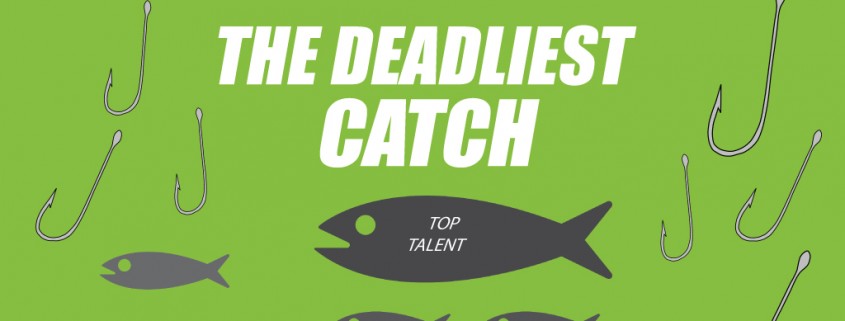Landing The Elusive, Unemployed Passive Job Seeker: Part 1
This is the first part of a three-part blog series on how your organization can attract and hire top talent by targeting Unemployed Passive Job Seekers as part of your overall talent recruitment strategy. Warning: There are a lot of fishing references.
The Deadliest Catch is a documentary series on The Discovery Channel. The show chronicles the lives of fishermen in the treacherous Bering Sea. They are on the hunt for one of the most coveted seafoods in the world–the Alaskan King Crab. The work is perilous, but the rewards for a big catch are impressive.
Finding and hiring top talent to fill your organization’s open positions is not a deadly job, but the rewards for catching the right candidate can be every bit as impressive. To make that happen, human resources departments need a talented crew, the right equipment, and–most importantly–a captain who knows where to fish.
And sometimes the biggest catch can be made in places you least expect.
A Check of The Weather Before We Set Sail
Earlier this month the U.S. Department of Labor released its latest jobs report. It indicated that the unemployment rate had risen by .1% to 5.7%. This was widely celebrated as a good thing. Why is an increase in the unemployment rate a good thing?
To answer that, we need to first look at the definition of the unemployment rate according to the US Bureau of Labor and Statistics.
Unemployment Rate: The number of unemployed (people who are jobless, actively seeking work, and available to take a job) as a percentage of the labor force (the sum of the employed and unemployed).
Nice. So this means that if you are unemployed, but not looking for a job, then you are not factored into the unemployment rate; therefore, an increase in the unemployment rate can mean one of two things:
- More people have lost their job AND they are currently looking for a new one
- More people–who were unemployed and not looking for a job– are still unemployed, BUT they are now looking for a job.
The experts are cheering because they believe #2 describes the nation’s current unemployment situation. So the weather seems to be improving, and the fish are ready to bite. But what if there was a way to catch these fish even before they were ready?
It’s possible. But to do that, we have to leave the safety and comfort of our job board shores, chart a course for new waters, and go fishing for an exotic species of job seeker.
Employed Passive Job Seekers
A Common Species
Individuals who have a job, but who are open to other job opportunities, are commonly referred to as Passive Job Seekers. These individuals may keep an updated resume on LinkedIn or maintain an active job board profile on Glassdoor. They are prepared to leave their current company if a better opportunity comes along, but they are not heavily motivated to go look for that opportunity.
Think of these as healthy fish that just aren’t hungry. They’re a protected species too, so let’s leave them alone. Poaching isn’t nice. We’re fishermen, not pirates. Well, not today at least…not until we have to fly the skull and crossbones in search of our next unicorn.
Unemployed Passive Job Seekers
An Exotic Species
Now for the sake of this discussion, let’s label another set of individuals as Passive Job Seekers. Let’s include individuals who do not have a full-time job and are not actively looking for one, but who are open to full-time job opportunities. These individuals are similar to Employed Passive Job Seekers in terms of their motivation to actively search for a job opportunity; however, they are facing conditions that preclude them from holding a full-time job. These are the Unemployed (or Underemployed in some cases) Passive Job Seekers.
Let’s think of these as healthy fish that aren’t looking for food because the waters are too turbulent. Now, that doesn’t mean they’re not hungry. It’s just that the waters are all muddied up and they’re not going to bite unless you catch their eye with a flashy lure–your employment brand.
Identify An Unemployed Passive Job Seeker
Skilled fishermen know every detail about the fish they seek. They know where the big catch will be and what motivates them to bite. A skilled recruiter must be the same way when it comes to sourcing candidates for jobs.
Here are several reasons why Unemployed Passive Job Seekers cannot actively look for a full-time job:
- They hold a part-time job
- They do small contract jobs/projects
- They are stay-at-home parents
- They have specialized experience in an industry that is not hiring/growing
- They are in school for further training
- They are ill or disabled
- They are discouraged
As you can see, none of these reasons is “just plain lazy” or “unemployable”–though that may be the case in some instances. The thing is, many talented workers are “unemployed and not looking” for good reason, or for reasons outside of their control; and while they may not be looking for a job right now, they could be interested in a position with a shiny organization that catches their eye.
Start Your Fishing Trip
If your organization is looking to hire additional employees–especially in an industry that has not been hiring for a while–targeting Unemployed Passive Job Seekers is a great way to increase your pool of quality applicants and land the big catch.
Now that you’ve identified this exotic species of job seeker, you’ll need tips on how to lure them in. Check back next Wednesday to learn how!









 15% OFF FULL-SERVICE HIRING • APPLICANT TRACKING SOFTWARE • ONBOARDING SOFTWARE
15% OFF FULL-SERVICE HIRING • APPLICANT TRACKING SOFTWARE • ONBOARDING SOFTWARE